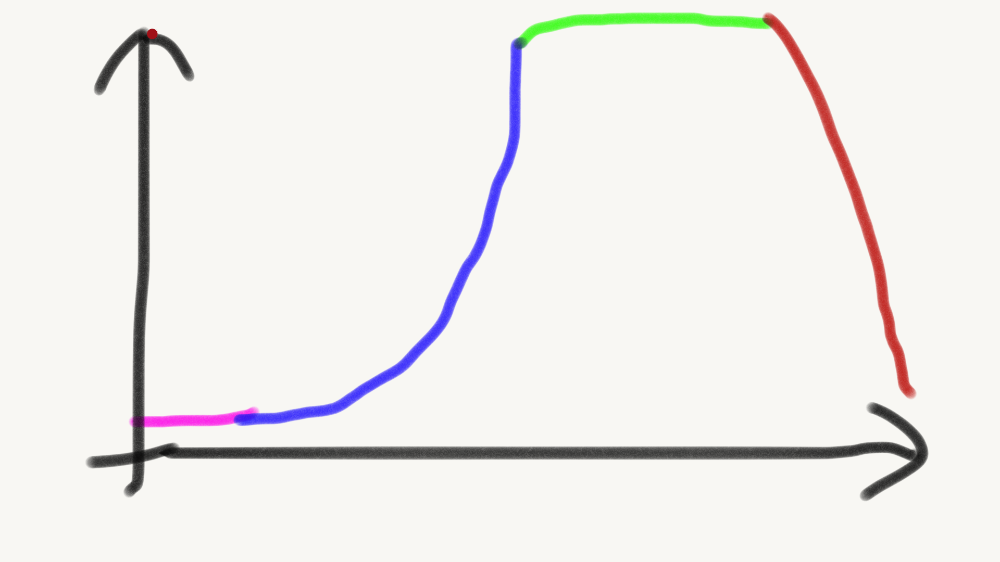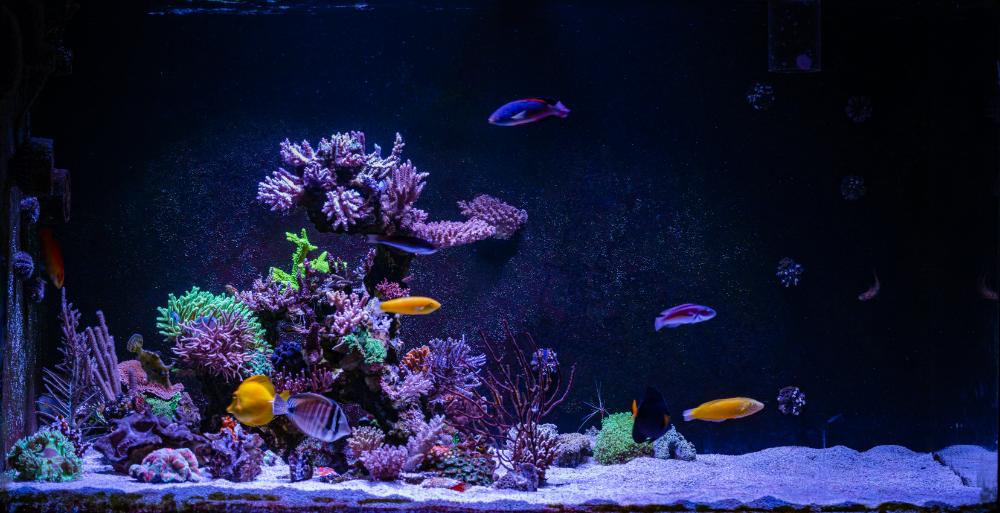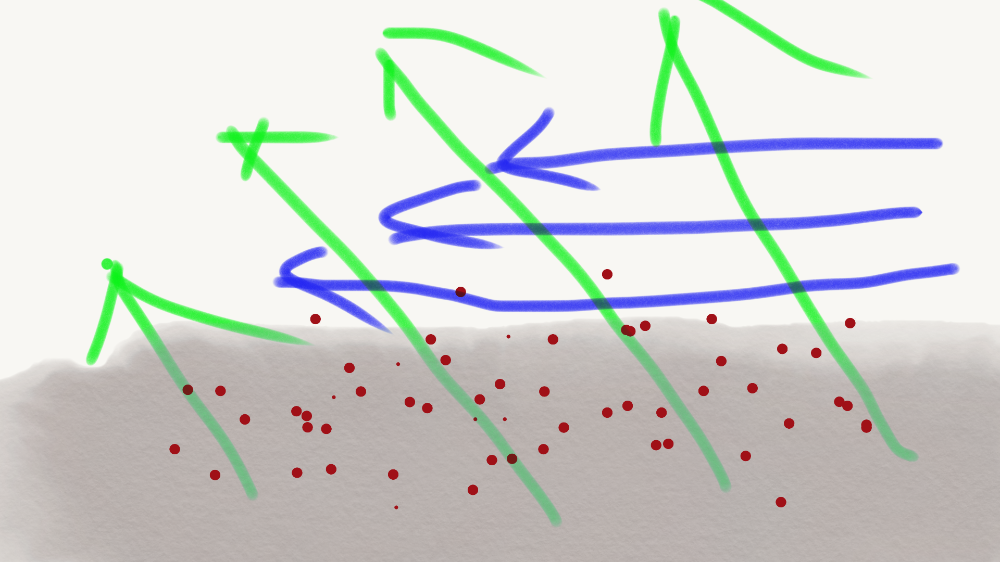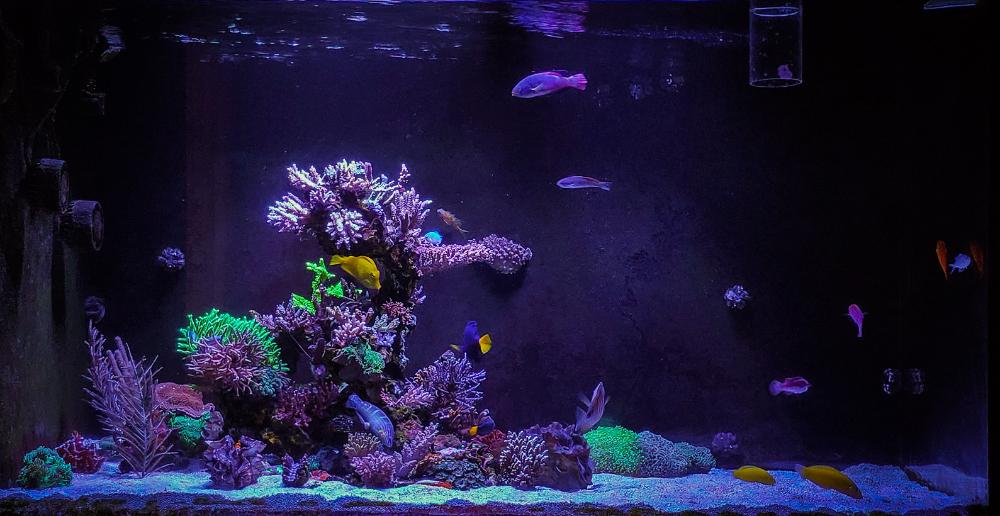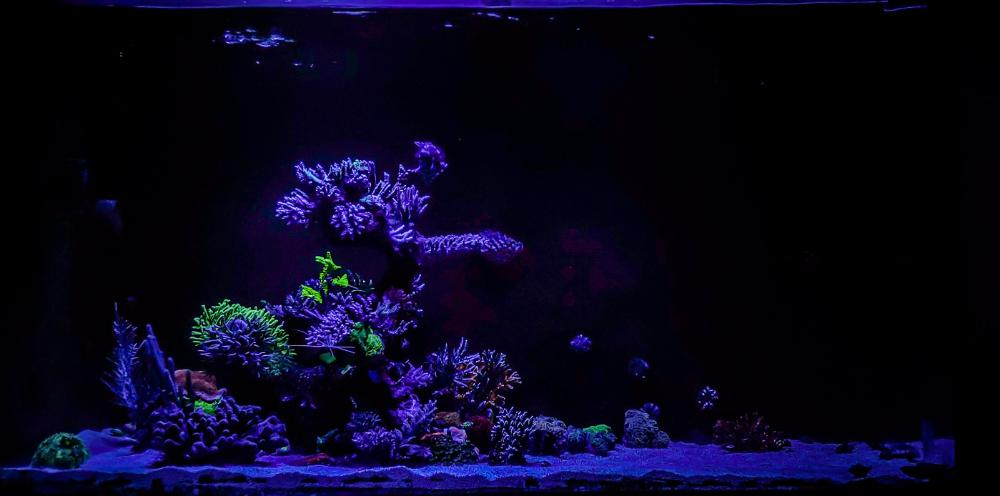-
Posts
304 -
Joined
-
Last visited
-
Days Won
15
Content Type
Profiles
Forums
Gallery
Everything posted by JiaEn
-
This is a tridacna noae, or the tear drop giant clam. Squamosa clams have a less enlongated, and more symmetrical shell. Also, the scutes (scale/fins) are more obvious on squamosa clams.
-
Bacterial Dynamics (II) In our reef aquarium, bacteria will not grow indefinitely. The limitations of space, nutrients, oxygen, and chemical warfare plays an important role to decide the size of the bacterial populations. Since we manage bacteria to ensure there is sufficient nutrient export in the aquarium, I would like to propose a simple concept: target bacteria population. this is the population of bacteria needed to metabolise the nutrients to be exported. An aquarium with higher bioload needs a larger population of bacteria to export the nutrients. While a aquarium of smaller bioload cannot support a large population of bacteria in a stable way. Phases of Bacteria Growth Perhaps you have seen a curve like this before. The sketch below illustrates the growth of bacteria in a system. The vertical axis represent the bacteria count, while horizontal axis represents the time. When bacteria is first introduced in a system, it needs time to adapt to the environment. This is the lag phase, represented by the magenta portion. The bacteria hardly grows - and since they don't grow, they will not take up nitrates and phsophates in a meaningful way. After the bacteria is adapted, they enters the exponential phase, represented by the blue portion. The growth at this stage is similar to the ideal condition described in the previous post: the impact of bacterial growth is small at first, but grows rapidly towards the last moments of this phase. As the nutrients started to be used up, the growth slows and eventually we arrive at the stationary phase, represented by green. Here the bacteria reproduces and dies/removed at the same rate, and the bacteria count is largely constant. Finally, if the nutrients run out, or if the enviroment becomes adverse, the death phase takes place, represented by maroon. The bacteria population drops, and may stablise at a lower level. For Our Reefs We want to achieve two things in our reefs: 1. Keep the bacteria population at the stationary phase. 2. Match the stationary phase population to the target bacteria population of our reef. The first point is simple. When our reef environment don't fluctuate too much, the bacteria population will generally fall within the stationary phase after tank cycling. The second point, on the other hand, is a lot more important. When the bacteria population match the export need, everything will be breezy. If the nutrient as a whole increases in a balanced way, the bacteria population will increase, and level off at a higher stationary phase. The problem comes in when some nutrients are not available, or some conditions may be adverse (such as antibiotics, or lack of oxygen). Then the population of bacteria can no longer increase. The exporting will be insufficient. /unrelated full tank shot/
-
Try it out and see if it works. This is my experience, illustrationed in the diagram below. Grey represent the sand bed. Red dots are detritus. A gyre flow is represented in blue, which probably can only carry off the detritus at/near the surface. To effect a good cleaning of the sand bed, the current needs to flow upwards, like the green lines. That's where turkey baster/siphon comes in. Sorry for blabbering so much on your thread. Keep the updates coming!
-
This would be ideal, yes. And a gyre style current does help to a large extent. However, the biggest obstruction to full tank gyre flow is.... obstruction. When the sheet of flow gets disrupted by the rocks, the gyre effect weaken really quickly. Don't get me wrong gyre flow is excellent and I also implement it in my aquarium. The tricky thing is, for many smallest sized particles, they are the size of fine sand, or even smaller. For my tank, even though there is almost no detritus on my rock, the sand bed will always have these detritus. Perhaps from the excretion of microfauna, or perhaps diatoms or whatever. Detritus produced in the sand bed would be quite difficult to lift off on it's own. That's why I rigorously clean my sand bed, and appreciate a rock work which allows me to reach as much place as possible. I think this is one very important observation. I believe many fishes are constanted over stimulated through their lateral lines due to all the vibrations in the tank. I also think the tank noise may affect their vocal communications, and potentially make it more difficult to establish healthy social structure.
-
This calls for a full tank picture!
-
If you Google great barrier reef, most pictures you will see are miles and miles of coral, growing on boulders (or coral remains). Most of the dive sites I have been to (not many), most of the reef don't have sandy substrate. Thats why I say sand bed looks right for us, but it's not really in the close proximity to many of the corals we keep. Keep the updates coming! Look forward to see your tank growing out.
-
Thanks for the response! I am using caribsea special grade too. Since I clean sand regularly, this is what I observe: if I were to shift any corals or rocks, the detritus traped beneath them is fairly significant. That's why I'm interested to know if there are other ways to manage those. I like the look of sand bed as well, even if a natural reef normally don't have one. Do be careful if you are going to keep sand sleeping wrasses. They may excavate under the rock and get themselves crushed under the rock.
-
Dynamics of Bacteria One of the most potent, but invisible, part of the reef ecosystem is that of the bacteria. Different bacteria population wax and wane as the reef conditions change. Even in the most stable of reefs in the wild, the bacteiral composition fluctuates regularly. Similar in our reef aquaria, bacteria plays a key role in keeping the system stable. In fact, we reefers often manipulate bacteria population to tackle various problems in our reef tank. Therefore it is worthwhile to understand the dynamic of bacteria growth, such that we can have the correct expectation as to how a bacteria product should work. Most Ideal Conditions Let's look at the simplest situation, where we start with a single bacterium, and let the population grow. Suppose there is plenty of resources and no competition, how would the bacteria population change? Bacteria reproduce through binary fission. This is the process wherrby one bacterium splits into two. So the single bacterium becomes two, two bacteria becomes four, then 8, 16, 32..... This results in two very interesting implications. 1. At the early stage, the number of bacteria increases very slowly, it will take a few cycles of fission before there is a meaningful number of bacteria in the system. 2. At the later stage, the bacteria growth is impressive. One trillion bacteria can become two trillion in the same duration as it takes for one bacteria to become two. For Our Reefs If we keep this in mind, some of the things we do will make perfect sense. When we cycle the tank, the bacteria need the time to divide and colonize all surface. Because of the dynamic of how bacteria grow, very often the nitrification capability (which depends on the number of bacteria) stays low for many days. Does adding more bacteria from a bottle help? Not really. The existing bacteria in the aquarium, which have been dividing for a few days, is much more than what little bacteria there is in any bottle. For those who carbon dose, it is often recommended to start with a smaller amount. The bacteria dynamic explain this very well. At the beginning of carbon dosing, the number of bacteria (the species we want) is low. As a result, they can only make use of a small amount of carbon. The unused portion may end up taking up be nuisance species, causing problems in the aquarium. Therefore, it is prudent to matching the carbon dosing to the bacteria growth dynamic. Which means start with a small amount, and slowly increases as the bacteria grow. This is a very crude picture of how bacteria work. I will discuss a more realistic model in the next post.
-
The Road of Recovery The recovery process is slow and painful. A few more coral were too weakened from the temperature shock, and bleached a long the way. Some others, spurred on by the stress, starts to put out more growth shoots. Corals will have to take their time to recover.
-
Great set up! A question for your rock scape though. What's the plan to reduce build up of detritus around and beneath the rocks? In my previous set up, I had something like yours. However the trapped detritus is rather inaccessible. That's why I went for a more skeletal rockwork for my current set up. Interested to hear your take on this. Thank you.
-
Great info! Diatoms are often mis-accused by reefers. Totally agree. Having diatom as dominant algae in the aquarium is actually a good defense against more detrimental species. Not to mention many corals prey on these planktons too. Diatoms are also an effective means of phosphate export. This is where we are different. I would blast the sand so that more corals can feed on these tasty stuff. Also, at the same time, maintain diatom dominance in the aquarium.
-
The problem of colormetric tests is that it tends to be rather subjective. They are also rather dependent on ambient light conditions. I would not worry too much at this stage. Just let your tank take its pace to cycle. Do ghost feed a bit though. Because we not only want to build up nitrifying bacteria, we also want bacteria which help to decompose other organics.
-
Exciting project!
-
Thank you @Willy Guccivera Yap.
-

5ft vs 6ft long – is it a major difference?
JiaEn replied to Max M's topic in New to the Marine Aquaria Hobby
A bigger tank gives you more opportunities, but also give you more challenges. Pro: More space to stock corals Marginally more fishes Slightly better buffer against fluctuations Con: More costly to light More difficult to ensure good flow throughout the tank More time for maintenance IMO both will work well. What's more important is that you start with most demanding livestock in mind. For example, if you were to under-provide the flow, you may do ok with softies and lps. However, if you choose to start keeping sps and realise you need to upgrade, a tight space around your tank may become a costly constrain. What I mean is, you can start with Hardy livestocks, but make provisions and plans to fullfill the need of delicate livestocks now. -
It could be precipitation, or bacteria film. You can check your Ca, Mg kh readings, but it's really not crucial during cycling period.
-
It's at the pipe joint at the compressor end. The compressor was one of the units left by the previous owner when we bought the house. So it's been many many years.
-
A Month of Mishaps Several unfortunate events took place this month. Here's a run down. 1. Bye-bye Achilles At the beginning of the month, my achillies tang suddenly came down with a severe bacteria infection. It died after two days. The running of zeo system precludes the use of UV and Ozone, that is one down side I have to keep in mind. This is an important consideration for me to stay away from some fishes as long as I'm using zeolite based filtration. Also, for a system which is very bacteria driven, I think its also potentially conducive for pathogenic bacteria to replicate rapidly. Therefore I will steer towards a lower fish load to give me larger margin. 2. Unchin and Clam One of my urchin fell on a squamosa clam, and got stuck in the inhalent siphon. It's a case of mutually assured destruction. Very unfortunate. 3. Compressor and Jinx I was sharing with a reefer that compressors are very reliable. The same night, the compressor leaked. When I realised my birdnest corals are uncharacteristically bare, my aquarium temperature is at 30.5 degrees. What a case of global warming in my own living room. Fortunately, iwarna was able to help install a new compressor the next day. My Acropolis endured with majority of it's inhabitants alive. The color of the coral is washed out somewhat. But if they survive, it is just a matter of time before the color comes back. The surge of temperature also wrecked havoc on my microbe population. There is probably some die-off, as well as some rebalancing of dominant bacteria colonies. It will be a while before the system stablizes again. Nightfall on Acropolis, here is to a less eventful May.
-
The idea is, there is only so much light getting in the tank. For a given light fixture, you can have intensity, by having a taller rock work. However, this will reduce the available light around it, especially when the coral grows out. It's not a bad thing, because it allows you to keep light demanding corals. It's all about proportion. Let your show piece dominate, and let your scape support it. It's not always bigger = better. Dragon and cat. Perhaps you can keep a few dragon sps, and a catalaphyllia or two at the back near the shade. All the best!
-
A simple and effective approach! Just make sure there is no excessive splashing and salt creep, this will go a long way to help gas exchange, which is very important. For export wise, I agree that for very small tanks, protein skimmers may be not essential. Once more corals and other living things are added. The demand for gas exchange will be even greater during dark hours.
-
Hey. Sorry if I have missed out the info. Are you using a protein skimmer? Without it, you may be facing some gas exchange issues. When the carbon dioxide is not adequately removed from the water, it really drives the pH down. Another possiblity is got to do with the room. If the room is poorly ventilated (for example, due to use of air con), the carbon dioxide level is gonna be high. This will impact the tank pH as well. The various micro algae photosynthesize in the presence of light. So even without any corals, there could be a sizable population of photosynthetic organisms. Another aspect to consider, is your personal routines. If more people are indoors at night, and doors and windows are tightly closed, then the carbon dioxide level in the room is gonna increase. This could also contribute to the trend you see. I'm a bit weary about borate buffer though. They may interfere with the alkalinity measurements down the road when the root cause of low pH is addressed.
-
This is interesting but also there is a lot of challenges. Having so many different varieties of DOC, so may be just measuring a 'level' may be insufficient. Wonder if anyone have access to HPLC setups. That would be a good step forward. @SubzeroLT will you be keen to take up some bacteria culture and counting next?
-
Agree with @SubzeroLT that diatom is really not a huge problem, and waiting for it to pass is probably the best course of action. I think what you should try next is to start managing the potential algae issues. Two actions to consider: 1. Introduce competition: Nothing in your aquarium competes with algae for nutrients at this point. So most of the available nutrients will be take up by algae eventually. This is not ideal. Start with some less demanding corals, and allow them to settle down and start taking up nutrients, goes a long way towards curbing algae bloom. 2. Introduce herbivores: I saw that you have introduced some snails. But it is not realistic to expect them to graze on all types of algae. Start to diversify your clean up crews, and also include some detrivores. Rather than having 5-7 snails of the same type, having 5-7 different type of clean up crew will be much more effective. It also reduces the chance of them starving.
-
Yes. @ROB We meant the same thing. Just like @peedeers said, the skimmer shifts the aquarium water towards an equilibrium with the environment air. So for massively oversaturated dissolves oxygen level, skimmer will bring them down somewhat.
-
/accidentally posted This actually make sense because our reef becomes supeesaturated due to photosynthesis. So perhaps additional skimmer for gaseous exchange is not needed/counter productive during day light hours.



